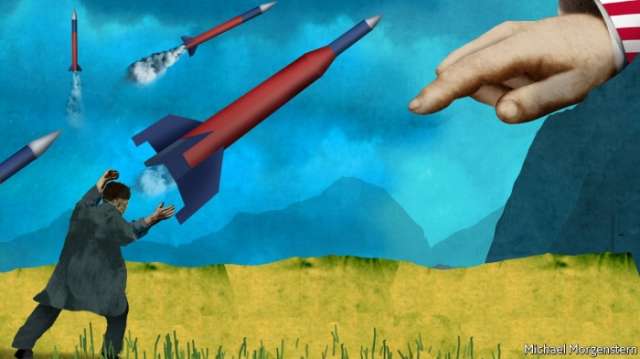A simple answer is that only vigorous testing can advance a country’s missile programme—and that Mr Kim sees the ability to launch nuclear-tipped missiles as the key to his regime’s survival in the face of American hostility. Rocket failures can be as important in what they teach you as successes, and North Korea has had plenty, with many missiles blowing up at launch or soon after.
But the successes are striking, too. Last year the North fired what is thought to have been a solid-fuel missile from a submarine, a first. A similar missile was launched in February by land. Analysts think this to be a big advance on North Korea’s previous liquid-fuel rockets. Land-based missiles with solid propellants can be readied for launch much faster, before enemy satellites or drones spot them. They may in future give Mr Kim a more credible land-based missile force, able to lurk in caves and then “pop up to fire when ordered,” says Peter Hayes of the Nautilus Institute, an American think-tank.
The North’s missiles have a range of up to 1,200 kilometres or roughly 750 miles—enough to hit South Korea and Japan, both of which host American bases, but not to reach the American mainland. But in a new-year speech Mr Kim promised an inter-continental ballistic missile (ICBM), capable of crossing the Pacific. He is not there yet. The North has enough fissile material for up to 20 nuclear weapons. But it has not mastered putting them on a warhead and accurately delivering them.
A second interpretation is that the tests are mainly intended as propaganda. Apocalyptic threats go hand in hand with missile and nuclear development. “South Korea will be submerged in a sea of fire, Japan will be reduced to ashes and the US will collapse.” thundered Rodong Sinmun, the ruling party’s chief mouthpiece, last month. At home, such bombastic language, learned from the Soviets, is intended to rally the country behind the regime in the face of perceived threats. And since no peace treaty ever ended the Korean war of 1950-53, the government can more easily convince North Koreans that they are on a war footing. Abroad, the intent is to hide North Korea’s immense weakness: no credible nuclear deterrent yet despite the recent progress, a backward army, a decrepit economy and a small, underfed population. Hannah Beech in the New Yorker likens North Korea’s prickliness to a hedgehog’s evolutionary strategy of showing its spines to protect its pink underbelly.
It is all of a piece with the notion, to which Western commentators frequently pander, that the Kim family regime is unpredictable and even irrational—handle with care! Yet both Kim Il Sung, the regime’s founder, and Kim Jong Il, his son, died of peaceful causes—testament to some good sense. Meanwhile, Kim Jong Un has defied predictions of a short reign at the time the callow heir succeeded to the throne. Ruthlessness is all. Sending all potential challengers including your uncle to be executed is a rational approach to staying in power in the mafia world of North Korean politics. If outsiders see all this as a sign of lunacy, so much the better: in the asymmetric warfare between North Korea and the outside world, a fearsome reputation can only be helpful.
There is a third possible explanation for the increased tests. Mr Kim may sense that they give him the best possible hand before American and Chinese pressure force North Korea back to the negotiating table. Donald Trump’s administration has been enlisting China to squeeze its wayward ally. In response to Mr Kim’s ICBM boast, the American president tweeted, “It won’t happen!” This week his defence secretary, James Mattis, declared North Korea, with its nuclear programme, to be the “most urgent and dangerous threat to peace and security”. Administration officials say that the threat has forced America to end years of “strategic patience” and consider riskier strategies. It remains hard to imagine, in the absence of an imminent threat, that America would launch a pre-emptive strike on North Korean missile sites. That would risk a devastating war on the Korean peninsula and be firmly opposed by South Korea. So the tests are likely to continue. But America may find ways to throttle the regime’s income from a global network of front companies peddling weapons and military technology in defiance of international sanctions, or—better yet—persuade China to curb North Korea’s oil imports. Mr Kim’s moment of maximum advantage may be now.
Who’s the crazy one now?
There is yet another possibility. What if Mr Kim sees the American government as crazy and capricious? He would not be the only one to view Mr Trump in that way. And Mr Trump has boasted about America’s recent missile strikes against a Syrian air base and the deployment of the world’s biggest conventional bomb against the Taliban. As Mark Fitzpatrick of IISS-Americas, a think-tank, writes, the rhetoric of deterrence “is a double-edged sword if it increases Pyongyang’s sense of paranoia”. It is perhaps alarming that the only American to whom Mr Kim talks is Dennis Rodman, an erratic former basketball star who visited Pyongyang this week. With the two sides communicating mainly through rhetoric and military signalling, what on earth, Mr Fitzpatrick asks, could go wrong?
This article appeared in the Asia section of the print edition under the headline "Double-edged deterrence".
More about: #NorthKorea #missile
















































